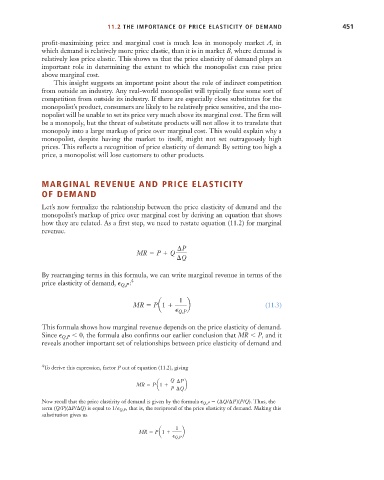Page 477 - Microeconomics, Fourth Edition
P. 477
c11monopolyandmonopsony.qxd 7/14/10 7:58 PM Page 451
11.2 THE IMPORTANCE OF PRICE ELASTICITY OF DEMAND 451
profit-maximizing price and marginal cost is much less in monopoly market A, in
which demand is relatively more price elastic, than it is in market B, where demand is
relatively less price elastic. This shows us that the price elasticity of demand plays an
important role in determining the extent to which the monopolist can raise price
above marginal cost.
This insight suggests an important point about the role of indirect competition
from outside an industry. Any real-world monopolist will typically face some sort of
competition from outside its industry. If there are especially close substitutes for the
monopolist’s product, consumers are likely to be relatively price sensitive, and the mo-
nopolist will be unable to set its price very much above its marginal cost. The firm will
be a monopoly, but the threat of substitute products will not allow it to translate that
monopoly into a large markup of price over marginal cost. This would explain why a
monopolist, despite having the market to itself, might not set outrageously high
prices. This reflects a recognition of price elasticity of demand: By setting too high a
price, a monopolist will lose customers to other products.
MARGINAL REVENUE AND PRICE ELASTICITY
OF DEMAND
Let’s now formalize the relationship between the price elasticity of demand and the
monopolist’s markup of price over marginal cost by deriving an equation that shows
how they are related. As a first step, we need to restate equation (11.2) for marginal
revenue.
¢P
MR P Q
¢Q
By rearranging terms in this formula, we can write marginal revenue in terms of the
price elasticity of demand, Q,P : 4
1
MR P a1 b (11.3)
Q,P
This formula shows how marginal revenue depends on the price elasticity of demand.
Since Q,P 0, the formula also confirms our earlier conclusion that MR P, and it
reveals another important set of relationships between price elasticity of demand and
4 To derive this expression, factor P out of equation (11.2), giving
Q ¢P
MR P a1 b
P ¢Q
Now recall that the price elasticity of demand is given by the formula Q, P (¢Q/¢P)(P/Q). Thus, the
term (Q/P)( P/ Q) is equal to 1/ Q,P , that is, the reciprocal of the price elasticity of demand. Making this
substitution gives us
1
MR P a1 b
Q,P

